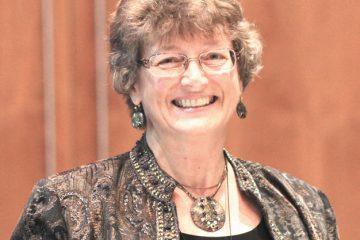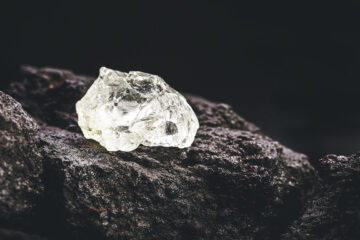Many splendored things
Jewish Family Identity Forum
Symbols of our values
By Candace R. Kwiatek, The Dayton Jewish Observer

“By the rivers of Babylon, there we sat and wept…” Exiled by the Babylonians from their land, their holy city Jerusalem, and their Temple, the Jews had been stripped of the familiar concrete symbols of their relationship with God. Yet they still desperately wanted a tangible symbol of their connection to the divine. It was at this point that the Torah — with its later additions of the Prophets and Writings — took on a central role in Jewish life.
Eventually, the Torah would become the universal identifying feature of the Jewish people: more than the land, the holy city, and the Temple.
Judaism has always celebrated the importance of objects as symbols of identity. The ancient Israelites carried with them the stone tablets of the commandments from Sinai; similarly, the Torah became their touchstone after the Babylonian exile. During the wilderness wanderings, the Jews were commanded to wear tzitzit (fringes), put a mezuzah on the doorpost, and build huts for Sukkot. Jews today are likely to have a seder plate, a menorah, Shabbat candlesticks and tzedakah box in their homes. Modern Israel flies a flag that recalls the design of the tallit and the colors of holiness. Each of these objects says something about Judaism: each is a reminder of God, obligation, ethics, history.
The connection between objects and Jewish identity is fascinating in Cincinnati’s Dead Sea Scrolls exhibition. There are washing basins and simple clay dishes from the holiness-obsessed monastic Jewish sect at Qumran. There are Tyrian shekels (silver Greek coins embossed with god-images) that Jews exchanged for blank coins to pay the Temple tax; yet those same Jews used Roman god-and-emperor embossed coins for everyday business.
There are ancient images of trees, doves, and pomegranates, once symbols of immortality and fertility, transformed by the Jews into representations of Torah, peace, and commandments. There are asherot, fertility figurines, alongside home hearth-sized incense altars. And there are the scrolls themselves, carefully wrapped and concealed in jars from the marauding Roman soldiers.
Consistent? No. And that’s perhaps one of the greatest beauties of this exhibit: it allows us to look behind the facade of the inspired, monolithic Israelites — bigger than life Jewish ancestors — and see them as humans: ordinary, accommodating, reverent, backsliding, segregated, stalwart, tempted.
You can picture them as your neighbors, with a string bikini next to a Bible and a Lexus next to the tzedakah box. Jewish alongside secular. Our ancient forebears are the stuff of biblical miracles, but also real: mythical and yet mundane.
These various musings swirl through my brain as my husband and I pack up Saba’s (grandfather’s) house for his move to smaller quarters. What do the objects he’s collected over the years say about who he is and what he values? Kipah and coffee maker. Mezuzah and magazines. Mythical and mundane.
Rescued from Nazi Germany, his massive mahogany desk and matching bookcase are stuffed with paperclips and files, and dozens of volumes on art, travel, and health alongside an equal number on Jewish philosophy, history, and literature. Prominently displayed on the walls are papercuts and sketches by family friends who perished in the Holocaust, balanced by Israeli art including a Sephardi wedding headdress and a watercolor by Yossi Stern. His favorite, though, is an impressionistic oil painting of sunflowers in a pitcher, a surprise gift from his wife.
There are photo albums and stacks of memorabilia tracing travels and loved ones’ lives. A half-dozen clocks. An extensive collection of Israeli stamps begun when Israel was still called Palestine. Encyclopedia Judaica. Photos of the grandchildren. A hand-scribed megillah. A bust by the famed Jewish sculptor Moses Ezekiel. Passover dishes and everyday pots and pans. Mythical and mundane, Saba is both unmistakably Jewish and comfortably secular.
The Jewish objects that are part of our lives both inform us and reflect who we are – or who we want to be. Certainly, there are the traditional ritual items, from the framed ketubah to the Kiddush cup. And then there’s art: a mizrach, a decorative plaque on an eastern wall. Israeli art, from posters to oil paintings. Photos of Jerusalem or Galilean flowers. Jewelry featuring a chai or hamsa.
Every home should be filled with Jewish books. Jews are, after all, the people of the book. Fiction, biography, folk tales, philosophy, politics; every literary genre is represented by Jewish authors or topics. And if not literature, what about music? From cantors to Carlebach, from Achinoam Nini to Idan Raichel, a multitude of sounds fill the airwaves.
The ancient Israelites were instructed to use specific objects to keep alive the Covenant of Sinai. The Jews of the Babylonian exile discovered the need for a tangible symbol of the Jewish story, the Tanakh (Hebrew Bible), to keep Judaism alive.
As an educator, I too have discovered the power of objects for Jewish learning and identification. Children learn about their world first, and most deeply, by exploring objects.
Families create powerful Jewish memories through objects. Adults need objects as Jewish touchstones in their harried secular lives. Seniors discover that Jewish objects are doorways for reminiscence and opportunities to pass down one’s heritage to a new generation.
Throughout our lives, we surround ourselves with various objects, each a symbol of our identity, of what we value. Mythical or mundane: what do the objects in your life say about you?
Family Discussion: Victims of natural disasters, such as the recent Hurricane Sandy, often have time to collect a few things before they evacuate. What objects would you take with you? What would your choices say about you?
Literature to share
The Mystery of the Dead Sea Scrolls by Hagit Allon and Lena Zehavi — Combining photographs of ancient artifacts and modern Israel and with clever cartoon figures, the authors and illustrator bring to life the discovery of the Dead Sea Scrolls and their importance. Written for upper elementary ages, this illustrated book from Jerusalem’s Israel Museum provides a simple, clear background for anyone wishing to visit the Dead Sea Scrolls exhibition at Cincinnati Museum Center.
Where You Left Me by Jennifer Gardner Trulson — If the author doesn’t have you hooked by, “’Come with me,’ my disheveled knight said,” on page three, you’ve been reading with your eyes closed. Equal parts memoir, love story, tragedy, and self-help, Trulson’s tale of the loss of her husband to terrorists on 9/11 and her struggle to recover life and love is inspiring. Those who attended her talk in Dayton will be able to visualize her telling her story. A must-read.



